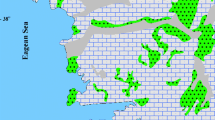Abstract
Mineral deposit grades are usually estimated using data from samples of rock cores extracted from drill holes. Commonly, mineral deposit grade estimates are required for each block to be mined. Every estimated grade has always a corresponding error when compared against real grades of blocks. The error depends on various factors, among which the most important is the number of correlated samples used for estimation. Samples may be collected on a regular sampling grid and, as the spacing between samples decreases, the error of grade estimated from the data generally decreases. Sampling can be expensive. The maximum distance between samples that provides an acceptable error of grade estimate is useful for deciding how many samples are adequate. The error also depends on the geometry of a block, as lower errors would be expected when estimating the grade of large-volume blocks, and on the variability of the data within the region of the blocks. Local variability is measured in this study using the coefficient of variation (CV). We show charts analyzing error in block grade estimates as a function of sampling grid (obtained by geostatistical simulation), for various block dimensions (volumes) and for a given CV interval. These charts show results for two different attributes (Au and Ni) of two different deposits. The results show that similar errors were found for the two deposits, although they share similar features: sampling grid, block volume, CV, and continuity model. Consequently, the error for other attributes with similar features could be obtained from a single chart.






Similar content being viewed by others
Notes
In “Case Study” section, we verify the efficiency of Eq. (1) to assess the real error in the block estimate.
The distribution of simulated values for block i is assumed to be symmetrical around E type.
References
Emery, X., Hernández, J., Corvalán, P., & Montaner, D. (2008). Developing a cost-effective sampling design for forest inventory. In J. M. Ortiz, & X. Emery (Eds.), Proceedings of the Eighth International Geostatistics Congress, Vol. 2 (pp. 1001–1010). Gecamin.
Goovaerts, P. (2001). Geostatistical modelling of uncertainty in soil science. Geoderma, 103, 3–26.
Koppe, V. C., Costa, J. F. C. L., Peroni, R. L., & Koppe, J. C. (2011). Choosing between two kind of sampling patterns using geostatistical simulation: regularly spaced or at high uncertainty locations? Natural Resources Research, 20(2), 131–142.
Li, S., Dimitrakopoulos, R., Scott, J., & Dunn, D. (2004). Quantification of geological uncertainty and risk using stochastic simulation and applications in the coal mining industry. In Orebody Modelling and Strategic Mining Planning (pp. 233–240). Melbourne: The Australasian Institute of Mining and Metallurgy.
Matheron, G. (1963). Principles of geostatistics. Economic Geology, 58, 1246–1266.
Matheron, G. (1973). The intrinsic random functions and their applications: Advances in applied probability, 5, 439–468. Retrieved December 8, 2006 from http://cg.ensmp.fr/bibliotheque/index.html.
Pilger, G. G., Costa, J. F. C. L., & Koppe, J. C. (2001). Additional samples: Where they should be located. Natural Resources Research, 10(3), 197–207.
Acknowledgements
The authors thank CNPq (Brazilian government research agency) for providing the financial support to this research and the Mining Planning and Mineral Research Laboratory at the Federal University of Rio Grande do Sul for providing computational facilities. The authors also thank the anonymous reviewers for their constructive comments, which helped us to improve the quality of our paper.
Author information
Authors and Affiliations
Corresponding author
Appendix
Appendix
As it was mentioned in the Methodology section, 80 scenarios were simulated for either the Au (ppm) or Ni (%) case. These 80 scenarios were considered adequate to assess the error in Eq. (1) based on several tests considering the simulated values for a block that showed high value of MEE (maximum estimated error). The value of MEE for this block seems to become constant for 60–80 simulated scenarios (see Fig. 7).
Rights and permissions
About this article
Cite this article
Koppe, V.C., Rubio, R.H. & Costa, J.F.C.L. A Chart for Judging Optimal Sample Spacing for Ore Grade Estimation. Nat Resour Res 26, 191–199 (2017). https://doi.org/10.1007/s11053-016-9317-0
Received:
Accepted:
Published:
Issue Date:
DOI: https://doi.org/10.1007/s11053-016-9317-0





